Len Joy's Blog, page 6
July 7, 2020
Do Not Go Gentle... part 2

I started my blog back in 2009 to chronicle my dual pursuit of trying to become a writer and a competitive triathlete. In last week’s post I talked about how important training was in my quest to become a better athlete. The same holds true for writing. Even a gifted natural athlete like Michael Jordan had to learn the fundamentals of the game – footwork, shooting mechanics, defense in order to become an accomplished performer.
For over fifteen years I commuted between Chicago and Phoenix where I operated an engine remanufacturing company with my brother-in-law. On those long flights I would dabble at writing stories and poems, but I didn’t know what I was doing. Didn't have the fundamentals.
Then in the summer of 2003, as we were winding down that business, I received a mailing from the The University of Chicago’s
The intro course was taught by writer, Barbara Croft. She was encouraging in the sense of “Keep trying if you enjoy it, but don’t quit your day job.” After the intro I took a flash fiction course, then short story fundamentals with author, Gary Wilson, a couple of poetry classes, a screenwriting workshop and finally a sequence of novel writing classes with
I started going to weeklong summer workshops. Over the next ten years I attended the
I joined the
I started participating in open mics. Chicago and Evanston provided many opportunities for writers to share their work in front of a crowd. And it’s not like stand-up comedy. The audiences were supportive.
Like any profession, the education is ongoing. I have a shelf-full of books on writing which I keep adding to. I’ll share some of my favorite craft books in another post.
June 27, 2020
How to Write a Novel... in 8 Years, 9 months and 3 days
Soon after I began getting serious about my writing career, I started a blog, “Do Not Go Gentle…” to chronicle my pursuit of a writing career and my efforts to become a triathlete.
My goals when I started the blog were to get my first novel published and to finish in the top 10 in my age group in the USAT National Championship.
I’m still working on that top 10 goal. My first novel, AMERICAN PAST TIME, was published in April 2014. But back on September 28, 2012, I announced that I was giving up on the novel which at that time was titled AMERICAN JUKEBOX:
,,When I finished American Jukebox again this spring, I knew it was truly finished. It was as good as I could make it. I’m proud of the work and in my heart I believe it “deserves” to be published. But that’s not my call. I’ve queried one hundred literary agents and also submitted the manuscript to a dozen small independent presses. Agents are overwhelmed with submissions and it’s hard to get noticed. Two agents asked to see my manuscript based on my query letter and one publisher who had looked at the earlier version agreed to reconsider the newest version. But it’s been weeks and I’ve haven’t heard from them and that’s usually a pretty good sign they are not interested.
,,I had planned to self-publish, but I’ve changed my mind. There are a lot of good self-published novels out there (also a lot of not-so-good ones). With Amazon and other programs I could have American Jukebox on the market in a couple of weeks. I like selling and if a publisher had bought my book I would have sold the hell out of it. It would have been fun. But without a seal of approval, I just don’t have the confidence to trump the decisions of the gatekeepers. Hawking my self-published book would take all my time and I need to get back to writing again. Something new. Something better.
Two weeks after I wrote that, I was contacted by Hark! New Era Publishing a small publisher who was interested in my novel. In this video I made for BQB Publishing, who are publishing my new novel, EVERYONE DIES FAMOUS, I talk about the ups and downs of getting that first novel published.
https://www.facebook.com/BQBPublishing/videos/549900909043515/
Do Not Go Gentle... part 1

,,Do Not Go Gentle Into That Good Night
Do not go gentle into that good night,
Old age should burn and rave at close of day;
Rage, rage against the dying of the light.
Though wise men at their end know dark is right,
Because their words had forked no lightning they
Do not go gentle into that good night.
Good men, the last wave by, crying how bright
Their frail deeds might have danced in a green bay,
Rage, rage against the dying of the light.
Wild men who caught and sang the sun in flight,
And learn, too late, they grieve it on its way,
Do not go gentle into that good night.
Grave men, near death, who see with blinding sight
Blind eyes could blaze like meteors and be gay,
Rage, rage against the dying of the light.
And you, my father, there on the sad height,
Curse, bless, me now with your fierce tears, I pray.
Do not go gentle into that good night.
Rage, rage against the dying of the light.
---Dylan Thomas
When I started my blog back in July 2009, my purpose was to chronicle my dual pursuit of trying to become a writer and a competitive triathlete at an age that might be described as “near retirement.” (I think that sounds better than old.)
I titled the blog, “Do Not Go Gentle…” because I liked the notion of resisting the inevitable decline of aging. I believed then, and I still do, that with good training (and some good luck) I could become a more competitive triathlete (in my age group).
I started racing in 2005. Through last year I have participated in 80 triathlons and 45 distance races (from 5K to marathon), including eighteen USAT National Championships and three ITU World Championships in Canada, Netherlands and Australia as part of Team USA. I also completed the Ironman at Coeur d’Alene and in 2017 I ran in the Boston Marathon.
It’s been a very rewarding experience.
I am not an elite athlete. I am an average cyclist, runner and swimmer (maybe a little less average at swimming, but I’m improving.) But I am very well coached.
Since 2012 I have been trained by Heather Collins of
That’s a serious commitment on my part, but if I had devoted all that time and tried to do it on my own, I would have failed. Learning (and maintaining) the proper technique and form and having the proper conditioning has made it possible for me to improve my relative performance in all segments and to avoid serious injury. It has kept me in the game, which was the goal all along.
Next week, I will talk about how professional training is also critical for my development as a writer. The two endeavors have some surprising similarities.
December 22, 2018
A high school basketball c...

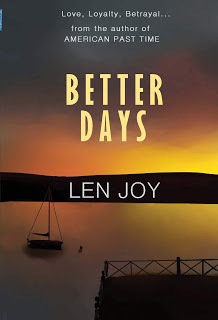
A high school basketball coach deals with small-town secrets.
From the outset of this novel, just about every aspect of Darwin Burr’s life in Claxton, 60 miles from Chicago, is set up for possible upheaval. He works at AutoPro, a nationwide car parts retailer, for his childhood buddy Billy Rourke, who has been involved in some increasingly questionable business practices. Darwin has a stable but cold relationship with his wife, Daina, who thinks he lacks ambition. Their daughter, Astra, is getting ready to try out for the high school varsity basketball team. That’s when the changes start. The team’s coach becomes ill, suffering chest pains. Billy arranges for Darwin, a former Claxton basketball star, to assist the school’s guidance counselor, Fariba Pahlavi, in coaching the team. Then Billy disappears as representatives from the corporate office show up looking to fire him and turn him over to the FBI. One of those reps, Stephanie Washington, steps in as the interim boss to audit Billy’s records. Adding to the turmoil, Darwin takes an interest in recruiting Toni, a young girl, for the basketball team and soon winds up trying to help her out of a difficult home situation. Everyone he knows has secrets, and they all seem to be revealed at once, forcing Darwin to figure out who he is without his support group. There are a lot of characters swirling around Darwin, the center of this story, and Joy (Letting Go, 2018, etc.) makes them all count. They each have distinct personalities, from the guy who owns the breakfast place to Daina, Fariba, and Darwin himself. The author has a good eye for telling details and exchanges between characters. At one point, when Darwin is trying to find out more about Daina’s past as a Latvian immigrant, he observes, “I learned that when she put my name at the end of her speech it meant our discussion was over.” This version of Claxton feels real, like North Bath, New York, in Richard Russo’s Nobody’s Fool. Perhaps the most impressive aspect of the book is that Joy avoids the temptation to wrap everything up too cleanly after introducing so many complications.A character-rich, skillfully plotted Midwestern drama.Publisher: Moonshine Cove PublishingProgram: Kirkus IndieReview Posted Online: Sept. 20th, 2018
This short-fiction collection examines various characters...

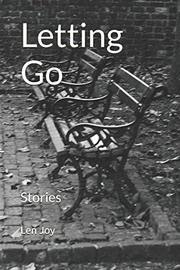 This short-fiction collection examines various characters’ reactions to death, past regrets, and other life changes.Joy’s (American Past Time, 2015) stories range from the wistful reminiscence of “Riding a Greyhound Bus into the New World,” in which a widower reflects on the young, inept man that he was on his honeymoon, to the more cynical “The Quick Pick,” in which an unusual couple builds a life by using the winning lottery ticket of a dead man. Many of the characters in these stories never seem to completely find peace, but some do reach some kind of redemption. In “Dalton’s Good Fortune,” for instance, a broken Vietnam vet finds salvation from a fortuneteller, and in “Nina’s Song,” a man who’s carried the unimaginable guilt of losing his sister in a mall ever since he was a child realizes that his family has never blamed him for her disappearance. Throughout these often very brief tales, no matter how dire, bleak, reflective, or celebratory they might be, Joy maintains a smooth prose style with a light touch that acts as a counterpoint to the darkness. At the same time, he fills the tales with imagery as exceptional as that in his debut novel, as in “The Girl from Yesterday”: “His face was all leathery, like boots after they get nice and broke in.” Among the life-changing epiphanies, Joy sprinkles in humor; “Pickup Line at the Ritz Carlton” is basically a setup and a punchline. He also evokes mystery in “Triage,” in which the wife of a retired, philandering surgeon suggests that he relieve his boredom by taking a mountain bike ride; this doesn’t turn out well, which leaves readers wondering about the wife’s motives. There’s also an engaging trilogy of connected pieces (“The Girl from Yesterday,” “Time Don’t Run Out On Me,” and the titular story) that follow different characters through a night on the town.Short, edgy tales with depth.Pub Date: May 21st, 2018ISBN: 978-1-981074-91-4Page count: 85ppPublisher: Hark! New Era PublishingProgram: Kirkus IndieReview Posted Online: July 11th, 2018Kirkus Reviews Issue: Sept. 1st, 2018
This short-fiction collection examines various characters’ reactions to death, past regrets, and other life changes.Joy’s (American Past Time, 2015) stories range from the wistful reminiscence of “Riding a Greyhound Bus into the New World,” in which a widower reflects on the young, inept man that he was on his honeymoon, to the more cynical “The Quick Pick,” in which an unusual couple builds a life by using the winning lottery ticket of a dead man. Many of the characters in these stories never seem to completely find peace, but some do reach some kind of redemption. In “Dalton’s Good Fortune,” for instance, a broken Vietnam vet finds salvation from a fortuneteller, and in “Nina’s Song,” a man who’s carried the unimaginable guilt of losing his sister in a mall ever since he was a child realizes that his family has never blamed him for her disappearance. Throughout these often very brief tales, no matter how dire, bleak, reflective, or celebratory they might be, Joy maintains a smooth prose style with a light touch that acts as a counterpoint to the darkness. At the same time, he fills the tales with imagery as exceptional as that in his debut novel, as in “The Girl from Yesterday”: “His face was all leathery, like boots after they get nice and broke in.” Among the life-changing epiphanies, Joy sprinkles in humor; “Pickup Line at the Ritz Carlton” is basically a setup and a punchline. He also evokes mystery in “Triage,” in which the wife of a retired, philandering surgeon suggests that he relieve his boredom by taking a mountain bike ride; this doesn’t turn out well, which leaves readers wondering about the wife’s motives. There’s also an engaging trilogy of connected pieces (“The Girl from Yesterday,” “Time Don’t Run Out On Me,” and the titular story) that follow different characters through a night on the town.Short, edgy tales with depth.Pub Date: May 21st, 2018ISBN: 978-1-981074-91-4Page count: 85ppPublisher: Hark! New Era PublishingProgram: Kirkus IndieReview Posted Online: July 11th, 2018Kirkus Reviews Issue: Sept. 1st, 2018BETTER DAYSLen JoyMoonshine Cove Publishing (Sep 21,...

BETTER DAYS
Len Joy
Moonshine Cove Publishing (Sep 21, 2018)
Softcover $14.99 (286pp)
978-1-945181-44-3Clarion Rating: 4 out of 5
Better Days is a bighearted, wry, and tender novel that focuses on love and loyalty.
Len Joy’s Better Days is an attention-grabbing crime story in which unexpected upheavals result in welcome second chances.
What’s the penalty for blind trust and loyalty? That’s the question Darwin Burr must answer when the FBI announces that his lifelong friend and now missing boss, Billy, is a person of interest. Mysterious envelopes stuffed with money, diamonds, and gold coins turn up out of nowhere, and Darwin’s leisurely work life at an auto parts distribution center becomes anything but—particularly since he’s always signed the papers Billy passed across his desk, no questions asked. Soon, everything in his life is called into question, including his marriage, his family, and his career.
Darwin narrates his tangled web with amusing slang and witty observations. His voice is a counterpoint to the story’s serious legal accusations and dark romantic temptations. Winning, laid-back prose belies the seriousness of Darwin’s situation, but turns up the tension to eleven as he seeks truth from those who say they are only trying to protect him.
Detailed scenes set in familiar bars and sweaty high school gyms are juxtaposed to spirited dialogue, resulting in a rhythmic text that moves at a clip. Through capable foreshadowing and well-timed revelations, the story negotiates absorbing subplots—especially around an endangered young girl, Toni, who is in Darwin’s charge, and her basketball coach for whom Darwin develops feelings. References to Toni Morrison’s The Bluest Eye, with its themes of racism and incest, bring in weightier topics than the novel’s primary themes of guilt and innocence, perhaps hinting at things happening offscreen in Toni’s life. This layered undercurrent adds more to contemplate, though such secondary story lines slow the novel’s pace, and the denouement feels delayed as a result.
There are many characters in this book, but they are all complex and realistic. Sympathy is secured when even the villains exhibit humanity, from a lawyer sent to take Darwin down who helps him instead, to a misanthropic prepper neighbor who becomes a powerful ally. This caring lineup of secondary characters is drawn with optimism that fits the story’s tone.
Appropriate punishments and rewards are meted out by the end, with puzzle pieces clicking into place to reveal the entire picture. Some characters’ secrets, now known, remain unacknowledged, and that silence reads as an act of love.
Better Days is a bighearted, wry, and tender novel that focuses on love and loyalty.
Reviewed by Drema Drudge
November 30, 2018
November 5, 2015
The Marathon Plan
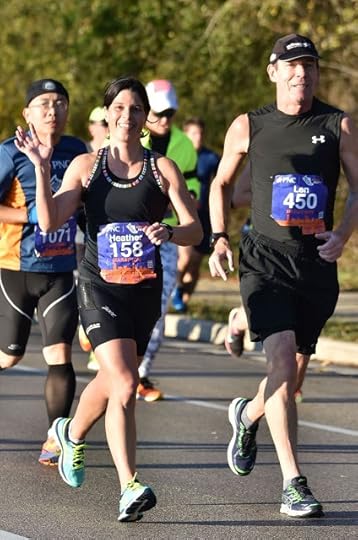 Mile 2 - Practicing our Synchronized Running Form
Mile 2 - Practicing our Synchronized Running FormOver the last ten years I have competed in fifty triathlons and a variety of 5k, 10K and half-marathons, but never a marathon. This year I decided to give it a shot and signed up for the PNC Milwaukee Running Festival, which was held Sunday, November 1, 2015.
My coach, Heather Collins set up my training program and ran some training runs with me.
The Challenge:
· Design a program that would have me marathon-ready in November, while continuing to train for the USAT Nationals Olympic distance triathlon in early August.
· From years of triathlon training I have developed a good cardio-base so I didn’t need to build a lot of cardio endurance, but the minor hamstring and calf strains I had experienced over the last few years could become more serious problems at the longer distance.
The Program:
The program Heather set up was designed to help me:
1. Improve running biomechanics (proper foot placement, stride, cadence)
2. Increase strength and firing of the muscles used for long-distance running
3. Improve flexibility
4. Address hotspots before they become problems
· Precision Multisport Facility
I had two one hour sessions a week (usually Tuesday and Thursday mornings) at Precision Multisport under Heather’s guidance.
· Chiropractic care, massage and stretching
Instead of seeking help after an injury we implemented a plan of preventive maintenance with routine visits to The Wellness Revolution for chiropractic care and massage therapy. Dr. Tony Breitbach and his colleague Dr. Nick Scanio took care of the chiropractic care while Laura Price and Sheila Tan provided massage torture every two to three weeks. Both women told me the massages would be less painful if I stretched more. And for the first time in my life, I did become serious about stretching and foam rolling. It helped but the massages were still torture.
· Weight & Nutrition
When I trained and completed the Ironman at Coeur d’Alene in 2012 I weighed about 188. Over the next two years I brought my weight down to 178 and for the marathon my plan was to run at 173. I developed a weight loss plan that works every time. You can eat anything you want, including beer and pizza and wine and cheese, but you have to eat less of everything. Also it helps to record everything you eat (at least for a few weeks). I used MyFitnessPal to log my meals – as it has the calorie and nutrition information for most all foods I wanted to eat. The benefit of logging your meals and snacks is that it educates you. Do I want this 100 calorie Double-stuffed Oreo or would I prefer to use those calories for something more nutritious – like a beer?
My basic diet was a 300 - 400 calorie breakfast (cereal, banana, orange juice) a 400 - 500 calorie lunch (half sandwich, apple and yogurt), an 800 calorie wine and cheese course, and an 800 - 900 calorie dinner. I averaged about 2500 calories a day and on race day I weighed 173.
· Run Workouts
Heather set up three runs a week: a speed workout at the track on Sunday afternoon, a tempo workout along the lakefront on Wednesday mornings, and a long run along Lake Michigan on Friday afternoon.
Here is a recap of the running workouts:
Training period: June 1 to October 30
#of Workouts: 49 (16 speed, 17, tempo, 16 long)
Total Miles Run: 337
Longest run: 20
· Psychological Preparation
Almost nothing in life goes according to plan. The plan is a critical roadmap for getting you to your destination but you have to be prepared for the unexpected. On June 25thI managed to fall off my bike and crack the 5th rib in my back. While it was a painful, annoying injury, I healed quickly. I couldn’t run for about ten days, but we substituted computraining and I was able to resume regular training runs by mid-July.
Then one week before the race I managed to twinge my pack unloading the washing machine. I got immediate chiropractic and massage help from The Wellness Revolution and by race day I was feeling great.
There are a lot more opportunities for things to go wrong during a triathlon. And over the years I have made all the classic mistakes (making a wrong turn on the run, swimming off course, mechanical problems with the bike).
Those screw-ups helped prepare me for problems that can arise before and during a competition.
The Race
We had perfect weather for the race: sunny and 50 degrees. The course was hillier than I had expected, but not severe hills. Just a lot of rolling ups and downs.
Heather’s race strategy was for me to start the race at a 9 minute pace (or slower) and gradually increase to 8:45. Try to hold that pace through mile 20. If I felt strong, I could increase the pace to 8:35 or faster.
She knew that the most common mistake newbie marathoners make is to go out too fast. It is hard not to get caught up in the excitement at the start. I did go out faster than 9 minutes but not so fast that I burned out.
I ran the first 13.1 miles at a pace of 8:54, slowed slightly over the next six miles, but finished the last six miles at 8:54. My time for the race was 3 hours 55 minutes and 7 seconds. I had hoped to be under 3:55, but this was close enough. I felt strong throughout the race.
I think the marathon more than any race I’ve run, is all about the training. I came into that race rested and well-prepared. Issues that I’ve had in the past on longer distances, like foot pain or hamstring tightness didn’t develop. Since I’m not getting any younger, I have to attribute that to good coaching. And maybe my wine and cheese focused diet.
My time qualified me to race in the Boston Marathon in 2017. I am considering it.
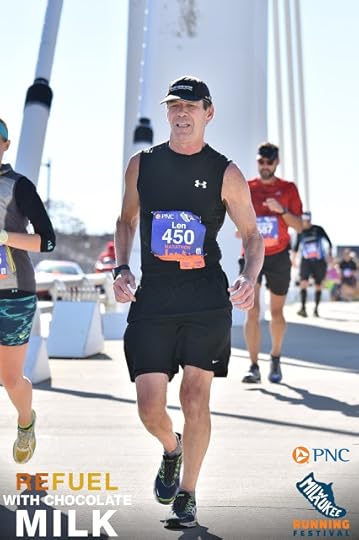 Mile 14 - The bridges are starting to annoy me
Mile 14 - The bridges are starting to annoy me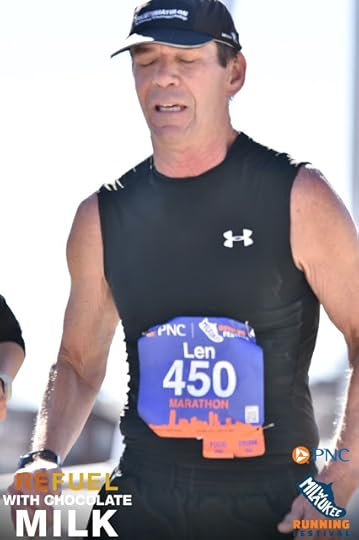 Mile 22 - Thinking about that chocolate milk
Mile 22 - Thinking about that chocolate milk
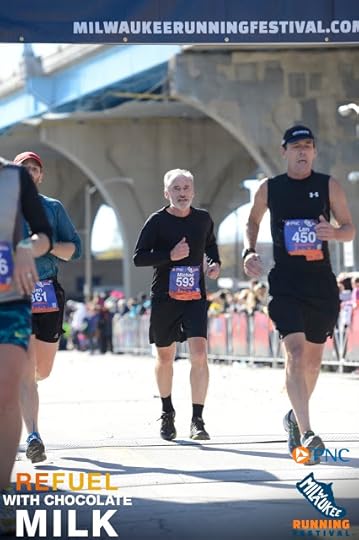 At the Finish Line - I just passed the guy behind me because I thought he might be in my age group. But he was wasn't.
At the Finish Line - I just passed the guy behind me because I thought he might be in my age group. But he was wasn't. August 24, 2015
Racing Weekend: Great Lakes Plunge & North Shore Triathlon
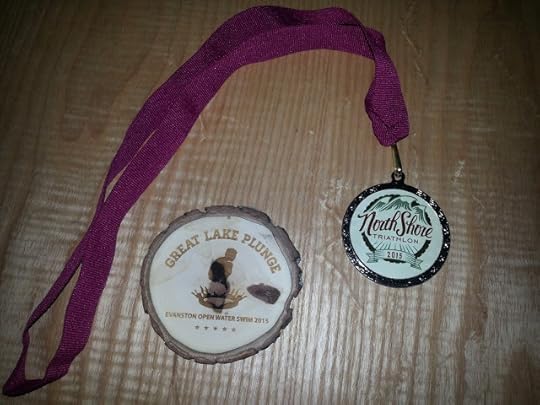
It was a great weekend for racing. On Saturday at Clark Street Beach in Evanston, we had the first annual Great Lake Plunge. While the water was a little cold it was a great event. Those swimmers are crazy. Most of the folks who signed up were planning to swim without wetsuits (not me). But because the water temp was only 53 degrees the race officials decreed that wetsuits were mandatory.
I signed up for the 1.2 mile distance. There were also 5 mile and 2.4 mile options, but because of the cold temps, the distance options were reduced to 1500 and 750 meters and I jumped on that 750 meter option. About 25 meters into the swim I was wishing my wetsuit had sleeves, but by 100 meters my brain was too cold to wish anymore and the rest of the swim was okay.
On Sunday we had the 3rd annual North Shore Triathlon at Gillson Beach in Wilmette. The North Shore Triathlon is the creation of Craig Strong and J. P. Bordeleau of Precision Multisport where I train. Craig and J.P. and a host of PM volunteers did a great job organizing the event.
Two years ago at the first North Shore Tri I entered the race as a relay team with my daughters. I swam, Christie biked and Nicole ran. It rained for the entire race and whenever I have asked them if they wanted to try it again, they just give me a look. Not a good look.
Last year the race was a month after my surgery and I couldn't bike so I had my friend Zeev Saffir do the bike segment and I swam and biked. Unfortunately last year the temp on race morning was 42 degrees.
This year the weather was perfect. I did all three segments. And despite swimming slightly off-course (which is hard to do on a straight line course) I had a great race. Averaged 20 mph on the bike and ran the 5K at a 7:33 pace. Took 1st in my age group.
This was my last triathlon of the year. Next race is the Lakefront Marathon in Milwaukee which I will be running with my coach Heather Collins. Our goal...is to make it to the starting line.
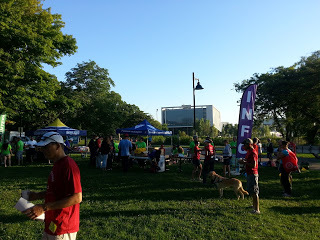 Check In for The Great Lake Plunge
Check In for The Great Lake Plunge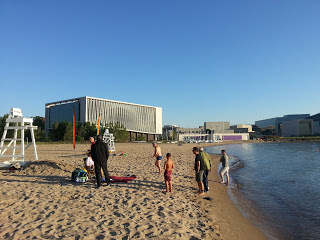 Waiting for the water to warm up (it didn't)
Waiting for the water to warm up (it didn't)
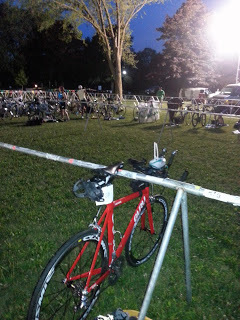 Beat the crowd to Transition
Beat the crowd to Transition A half hour later
A half hour later
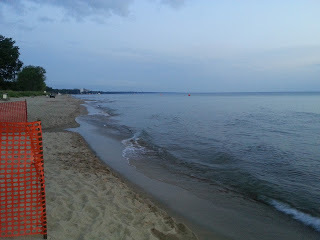 Cold water
Cold waterAugust 11, 2015
What Time is it Anyway?
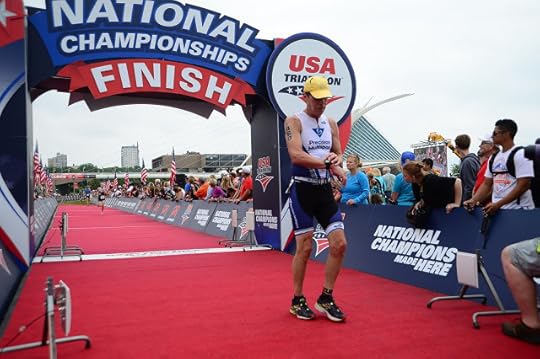
I started this blog in July 2009 with the stated purpose of chronicling: My writing endeavors; I was working on a novel which I was confident would be published to huge acclaim in no more than a year. And my triathlon training; my goal was to finish in the top 10 of my age group at the USAT National Championships in 2011 when I would be the youngest in the 60 to 64 age group.
It is hard to say which goal was more unrealistic. I think it might be a tie. Which shows that at least I am consistent.
The novel took six years and I’m still waiting for it to be discovered by Oprah or maybe HBO.
And I have now competed in five national championships without finishing in the top 50% to say nothing about the top 10.
But I have improved my tri performance each year. One of the problems is that the old guys I’m competing against keep improving too.
I wouldn’t have been able to improve at all if I hadn’t had great coaching – first with Craig Strong from Precision Multisport and these last three years with Heather Collins who works out of Precision also.
The 2015 USAT Nationals were held in Milwaukee last Saturday. It’s a great venue. I wish the USAT would keep the race there permanently – even though there are way too many guys walking around there with Packer jerseys.
I finished 52nd out of 85 in the 60 to 64 age group. BUT... ...next year I compete with the REALLY old guys (65 to 69) and my new more realistic goal is to finish in the top 25 (but my secret goal is top 20).
I also plan to publish another novel next year. Please let Oprah know. And here are more photos of me. They look very similar to the race photos from the last twenty races, except I keep looking a little older.
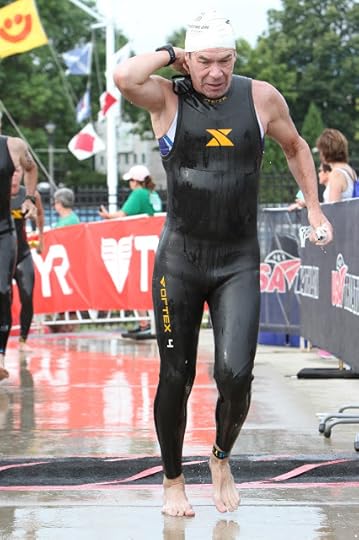
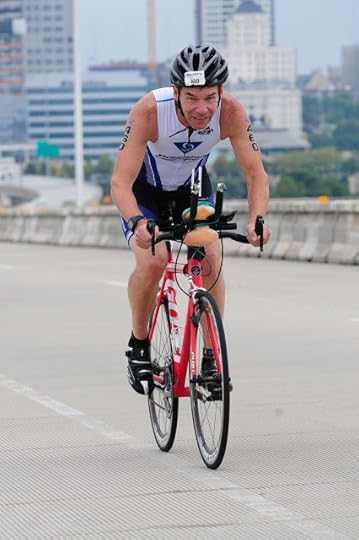
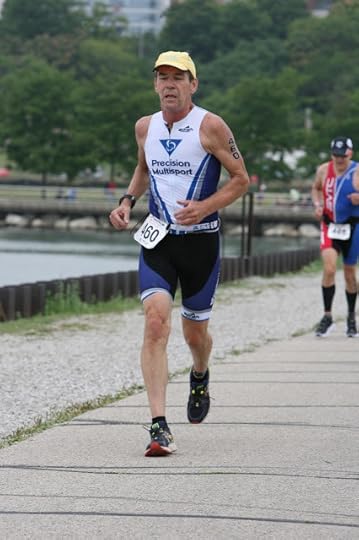

July 13, 2015
The Shoehorn Made the Difference

A shoehorn cost me third place (for my age group) in the Lake Zurich Triathlon yesterday.
On June 25th, in a freak accident, which I am not going to blame on my coach even though it happened because I was waiting for her to catch up to me, I fell off my bike and cracked a back rib.
The injury, while minor, made it difficult to maintain a normal training program. It hurt to run and I couldn’t swim because I couldn’t raise my arm over my head, but ironically, I could still bike without difficulty. However to be prudent and avoid the possibility of another freak accident I trained on the computrainer (pretty hard to fall off a stationary bike). J.P. Bordeleau of Precision Multisport set me up on a series of rides called “Sufferlandia”. Those training rides hurt more than falling off the bike.
So I was able to maintain a fitness level, but it was still doubtful I would be ready to race on July 12.
A week ago, I went back to the pool to see if I could swim. I could dog paddle, but it would have taken me an hour to finish the course. I also tried to run, and I was fine for the first ten yards, then not so fine.
But as they say, time heals all wounds. Last week I was feeling much improved. I still couldn’t roll over, but I could tie my shoes and feed the cat and do other important household chores. Wednesday I went for a slow jog and it didn’t hurt. So the Saturday before the race I went to Lake Michigan with my wetsuit – which is like wearing a life raft on your body. Lots of buoyancy which I figured might make it easier to swim. My theory was correct and once I took a few strokes my back loosened up and I could extend my arm so that my stroke was almost normal. It was a little hard to lift my head to spot for buoys but I thought I could manage it and decided to go ahead with the race. By the way – Lake Michigan is still really cold.
It was perfect weather for the race: cloudy and cool. And Lake Zurich was 75 degrees – wetsuit legal, but comfortable. This is a small race (about 500 competitors) and the waves were only about 60 swimmers at a time so I wasn’t too worried about getting kicked or mauled during the swim. I didn’t quite have my normal stroke – but I just took it easy and completed the swim without incident in about 35 minutes. In my last race I covered that distance in 32 minutes.
I had an easy transition. I had decided not to wear socks so I didn’t have to bend over and struggle to put them on. I had no problem on the bike, although as a concession to the injury I didn’t ride in aero position– as I promised my wife I would be careful. I also slowed down a lot on the corners. Even with all the caution I averaged over 20 mph (it’s a pretty flat course). I had a good ride and it was way easier than the computrainer rides.
It was on the transition to the run that the shoehorn did me in. I had a two part plan for managing the transitions with my limited mobility and that was to 1) skip the socks (which worked fine except that I ended up with blisters on the tops of my toes); and 2) use a long shoehorn to get my quick-tied running shoes on.
It almost worked great. The problem was that my sweaty sockless feet stuck to the tongue of the shoe and when I pried it on with the shoehorn – the tongue got all wrinkled. I couldn’t fix it so I had to take the shoe off and put it on the way I always do. That escapade with the shoehorn, cost me at least twenty seconds.
Full disclosure requires that I point out that my coach (the one who IS NOT IN ANYWAY RESPONSIBLE FOR THE ACCIDENT EVEN THOUGH IT HAPPENED WHILE I WAS WAITING FOR HER) has always suggested I not try anything during a race that I have not practiced beforehand (like using a shoehorn). I almost always follow her suggestions because 1) she tends to be right MOST of the time and 2) her suggestions don’t really sound like suggestions;
I had a great run. Maybe because my legs were fresh from not running at all for two weeks. I did the 10K at a 8:10 pace which is better than my other two races this year.
I finished in 2:45 and thought I had really good chance to make it to the podium. But I finished fourth – just .93 of a second out of 3rd place.
I blame the shoehorn.
Next race: The USAT Age Group Championships August 8, 2015 – Milwaukee, Wisconsin



